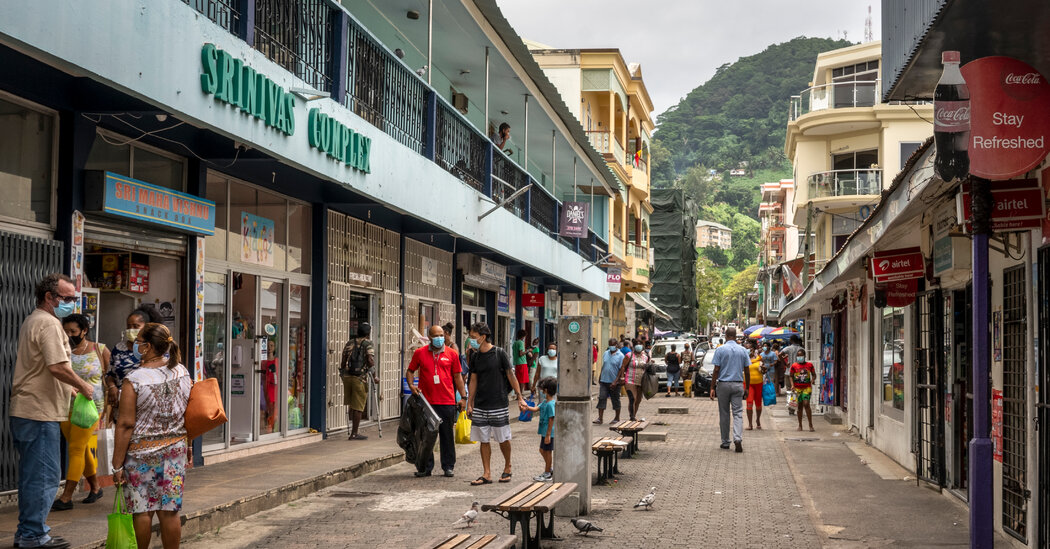ECONOMIC NEWS
Seychelles Sees Rise in Coronavirus Cases Despite Vaccinations
Marie Neige, a call center operator in Seychelles, was eager to be vaccinated. Like the majority of the residents in the tiny island nation, she received China’s Sinopharm vaccine in March, and expected to be fully protected in a few weeks.On Sunday, she tested positive for the coronavirus.“I was shocked,” said Ms. Neige, 30, who is isolating at home. She said she had lost her sense of smell and taste and had a slightly sore throat. “The vaccine was supposed to protect us — not from the virus, but the symptoms,” she said. “I was taking precaution after precaution.”China expected its Sinopharm vaccines to be the linchpin of the country’s vaccine diplomacy program — an easily transported dose that would protect not just Chinese citizens but also much of the developing world. In a bid to win good will, China has donated 13.3 million Sinopharm doses to other countries, according to Bridge Beijing, a consultancy that tracks China’s impact on global health.Instead, the company, which has made two varieties of coronavirus vaccines, is facing mounting questions about the inoculations. First, there was the lack of transparency with its late-stage trial data. Now, Seychelles, the world’s most vaccinated nation, has had a surge in cases even though much of its population was inoculated with Sinopharm.For the 56 countries counting on the Sinopharm shot to help them halt the pandemic, the news is a setback.For months, public health experts had focused on trying to close the access gap between rich and poorer nations. Now, scientists are warning that developing nations that choose to use the Chinese vaccines, with their relatively weaker efficacy rates, could end up lagging behind countries that select vaccines made by Pfizer-BioNTech and Moderna. That gap could allow the pandemic to continue in countries that have fewer resources to fight it.“You really need to use high-efficacy vaccines to get that economic benefit because otherwise they’re going to be living with the disease long term,” said Raina MacIntyre, who heads the biosecurity program at the Kirby Institute of the University of New South Wales in Sydney, Australia. “The choice of vaccine matters.”Nowhere have the consequences been clearer than in Seychelles, which relied heavily on a Sinopharm vaccine to inoculate more than 60 percent of its population. The tiny island nation in the Indian Ocean, northeast of Madagascar and with a population of just over 100,000, is battling a surge of the virus and has had to reimpose a lockdown.Among the vaccinated population that has had two doses, 57 percent was given Sinopharm, while 43 percent was given AstraZeneca. Thirty-seven percent of new active cases are people who are fully vaccinated, according to the health ministry, which did not say how many people among them had the Sinopharm shot.“On the surface of it, that’s an alarming finding,” said Dr. Kim Mulholland, a pediatrician at the Murdoch Children’s Research Institute in Melbourne, Australia, who has been involved in the oversight of many vaccine trials, including those for a Covid-19 vaccine.Dr. Mulholland said the initial reports from Seychelles correlate to a 50 percent efficacy rate for the vaccine, instead of the 78.1 percent rate that the company has touted. “We would expect in a country where the great majority of the adult population has been vaccinated with an effective vaccine to see the disease melt away,” he said.Scientists say breakthrough infections are normal because no vaccine is 100 percent effective. But the experience in Seychelles stands in stark contrast to Israel, which has the second-highest vaccination coverage in the world and has managed to beat back the virus. A study has shown that the Pfizer vaccine that Israel used is 94 percent effective at preventing transmission. On Wednesday, the number of daily new confirmed Covid-19 cases per million people in Seychelles stood at 2,613.38, compared with 5.55 in Israel, according to the World in Data project.Updated May 12, 2021, 5:51 p.m. ETWavel Ramkalawan, the president of Seychelles, defended the country’s vaccination program, saying the Sinopharm and AstraZeneca vaccines have “served our population very well.” He pointed out that the Sinopharm vaccine was given to people ages 18 to 60, and in this age group over all, 80 percent of the patients who needed to be hospitalized were not vaccinated.“People may be infected, but they are not sick. Only a small number are,” he told the Seychelles News Agency. “So what is happening is normal.”Sylvestre Radegonde, the minister for foreign affairs and tourism, said the surge in cases in Seychelles happened in part because people had let their guard down, according to the Seychelles News Agency. Sinopharm did not respond to a request for comment.In a response to an article from The Wall Street Journal on Seychelles, a spokeswoman for China’s foreign ministry blamed Western media for trying to discredit Chinese vaccines and “harboring the mentality that ‘everything involving China has to be smeared.’”In a news conference, Kate O’Brien, director of immunizations at the World Health Organization, said the agency was evaluating the surge of infections in Seychelles and called the situation “complicated.” Last week, the global health group approved the Sinopharm vaccine for emergency use, raising hopes of an end to a global supply crunch.She said that “some of the cases that are being reported are occurring either soon after a single dose or soon after a second dose or between the first and second doses.”According to Ms. O’Brien, the W.H.O. is looking into the strains that are currently circulating in the country, when the cases occurred relative to when somebody received doses and the severity of each case. “Only by doing that kind of evaluation can we make an assessment of whether or not these are vaccine failures,” she said.But some scientists say it is increasingly clear that the Sinopharm vaccine does not offer a clear path toward herd immunity, particularly when considering the multiple variants appearing around the world.Governments using the Sinopharm vaccine “have to assume a significant failure rate and have to plan accordingly,” said John Moore, a vaccine expert at Cornell University. “You have to alert the public that you will still have a decent chance of getting infected.”Many in Seychelles say the government has not been forthcoming.“My question is: Why did they push everyone to take it?” said Diana Lucas, a 27-year-old waitress who tested positive on Monday. She said she received her second dose of the Sinopharm vaccine on Feb. 10.Emmanuelle Hoareau, 22, a government lawyer, tested positive last Thursday after getting the second dose of the Sinopharm vaccine in March. “It doesn’t make sense,” she said. She said the government had failed to give the public enough information about the vaccines.“They are not explaining to the people about the real situation,” she said. “It’s a big deal — a lot of people are getting infected.”Ms. Hoareau’s mother, Jacqueline Pillay, is a nurse in a private clinic in Victoria, the capital. She said she believed there was a new variant in Seychelles because of an influx of foreigners who had arrived in recent months. The tourism-dependent country opened its borders on March 25 to most travelers without any quarantine.“People are very scared now,” said Ms. Pillay, 58. “When you give people the right information, then people would not speculate.”Health officials have recently appeared on television to encourage those who have taken only the first dose of the Sinopharm vaccine to return for the second shot. But Ms. Pillay said she was frustrated that the public health commissioner had not addressed why the vaccines didn’t appear to be working as well as they should.“I think a lot of people aren’t coming back,” said Ms. Pillay.Marietta Labrosse, Elsie Chen and Claire Fu contributed research.
Source link













